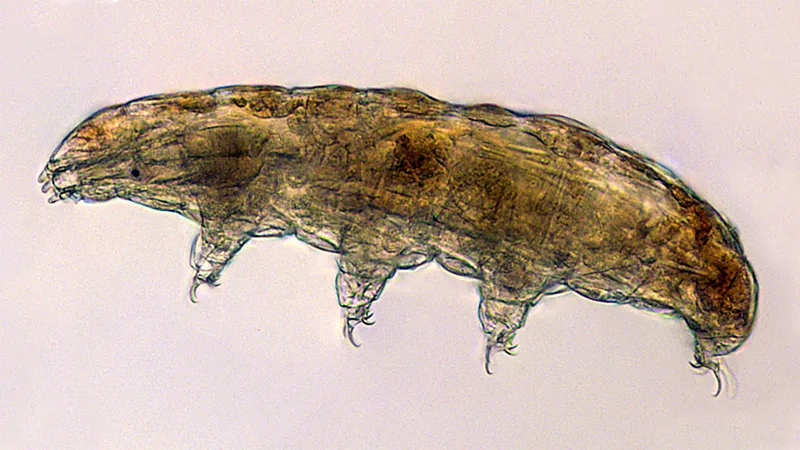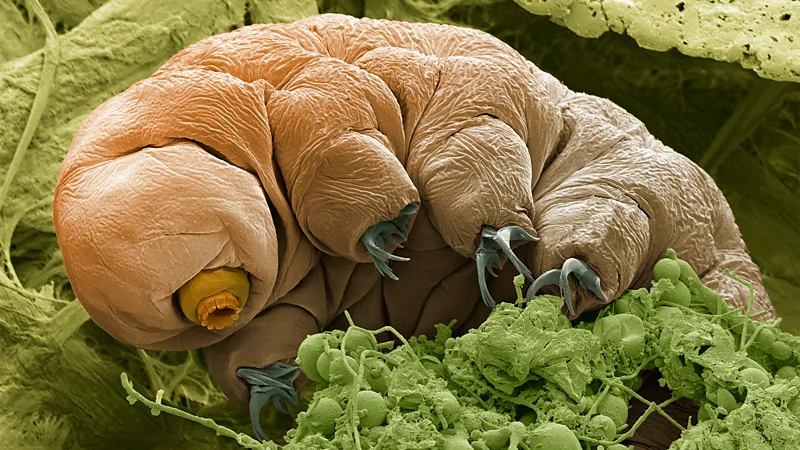Tardigrades — also called water bears or moss piglets — are some of the most resilient creatures ever discovered. These microscopic animals, measuring no more than a millimeter long, can survive being frozen near absolute zero, boiled at extreme temperatures, blasted into space, and even exposed to deadly levels of radiation. Scientists are now studying these tiny creatures to unlock the secrets behind their survival superpowers — and to use those abilities to protect humans, preserve medicines, and prepare for long-duration space missions.
What Makes Tardigrades So Special?
Under a microscope, tardigrades look like miniature monsters with pudgy bodies, eight clawed legs, and a mouth resembling a tiny vacuum cleaner. Despite their appearance, these creatures may outlive humanity itself. With over 1,500 species discovered so far, tardigrades are found across the planet — from the Himalayas to the ocean floor, in Antarctic ice, and even in hot springs.
Their ability to survive such extreme environments has earned them the reputation of being Earth’s toughest life form.
Tardigrades in Space: The Ultimate Survival Test
Perhaps the most fascinating proof of tardigrades’ resilience came in 2007, when they became the first animals to survive direct exposure to outer space. Scientists discovered that many tardigrades survived not only the vacuum of space but also the intense cosmic radiation. Some even laid eggs, and their young hatched healthy back on Earth.
In 2019, tardigrades were aboard Israel’s Beresheet lunar mission. Although the lander crashed on the Moon, researchers speculate that some of the microscopic passengers may still be there — possibly alive, waiting for the right conditions to revive.
The Secret Weapon: The Tun State
One of the main reasons tardigrades can endure extreme conditions is their ability to enter a state called cryptobiosis — more specifically, a form known as the tun state.
When faced with extreme dehydration, tardigrades retract their legs, curl up, and dry out until they resemble a tiny seed. In this state, their metabolism slows to just 0.01% of its normal rate, allowing them to survive for decades without water.
Incredibly, scientists have revived tardigrades after decades of being dried out — one even twitched a leg after being rehydrated more than 120 years later.
Tardigrade Survival Superpowers at the Cellular Level
Researchers have discovered that when tardigrades enter the tun state, they produce tardigrade-specific intrinsically disordered proteins (TDPs). These proteins form a gel-like shield around the cells’ internal structures, preventing damage while the organism is desiccated.
When these genes were inserted into bacteria and yeast, the other organisms gained extreme tolerance to drying out — suggesting that we could one day use this mechanism to preserve vaccines and medicines at room temperature.
Radiation Resistance: Dsup, the DNA Protector
Another tardigrade survival trick involves a unique protein called Dsup (damage suppressor protein). This molecule wraps around DNA, shielding it from radiation and preventing breaks. In 2016, researchers inserted the Dsup gene into human cells, which then became significantly more resistant to X-ray radiation.
This discovery could lead to medical breakthroughs — protecting cancer patients from the side effects of radiation therapy or shielding astronauts from cosmic rays on long space missions.
Tardigrades and Extreme Temperatures
Tardigrades can endure boiling temperatures as high as 150°C (302°F) and freezing temperatures near absolute zero — but only when in their tun state. If caught unprepared in water, they die as quickly as most other creatures.
Interestingly, some studies show tardigrades are vulnerable to rising global temperatures if they cannot enter the tun state in time. This means even these hardy creatures may face threats from climate change.
Tardigrades as a Key to Future Technology
The study of tardigrades is not just about curiosity — it could transform multiple fields:
- Medicine: TDPs could stabilize vaccines, eliminating the need for cold storage. Dsup may one day protect healthy cells during cancer treatment.
- Space Exploration: Understanding tardigrade resilience could help NASA protect food, medicine, and even human DNA on missions to Mars and beyond.
- Biotechnology: These survival mechanisms may lead to breakthroughs in preserving organs for transplant, extending their shelf life dramatically.
Why Evolution Made Tardigrades So Tough
Why would such tiny creatures evolve this level of durability? Scientists theorize that because tardigrades live in environments prone to drying out — like moss, lichen, and soil — they needed a way to survive until the next rain. Their small size also means they can be blown around the planet by the wind, landing in extreme conditions where these adaptations are essential.
Their survival traits may not just help them persist through climate cycles but also allow them to colonize new environments.

The Future of Tardigrade Research
As researchers decode more of the tardigrade genome, we may soon learn how to apply their abilities to human health, food security, and space travel. These tiny creatures could help us face some of the greatest challenges of the future — from cancer treatment to interplanetary colonization.
For now, tardigrades continue to amaze scientists and inspire curiosity. They are a living reminder that even the smallest life forms can hold the keys to survival on a changing planet — and perhaps beyond Earth itself.
Source: BBC Future


